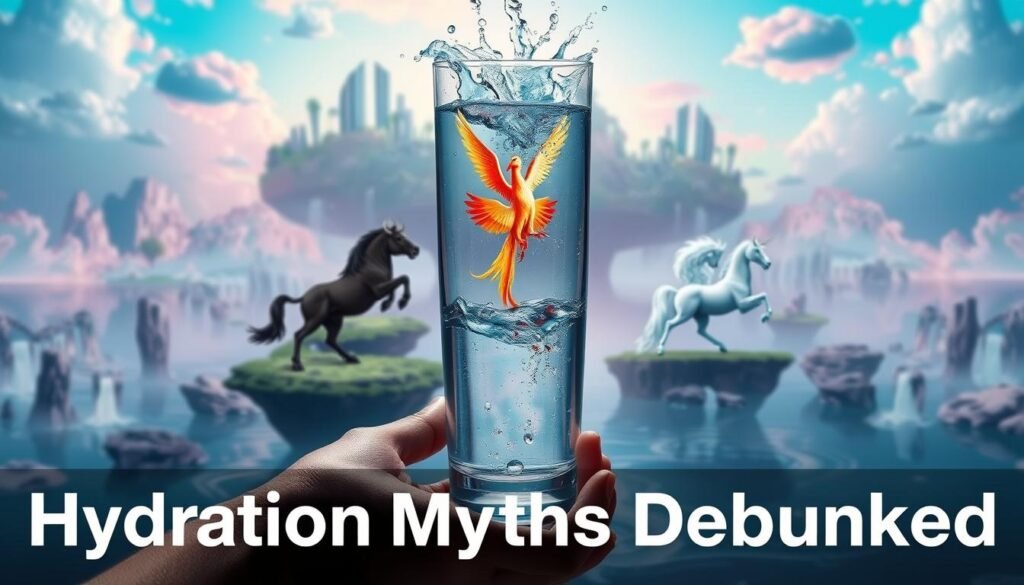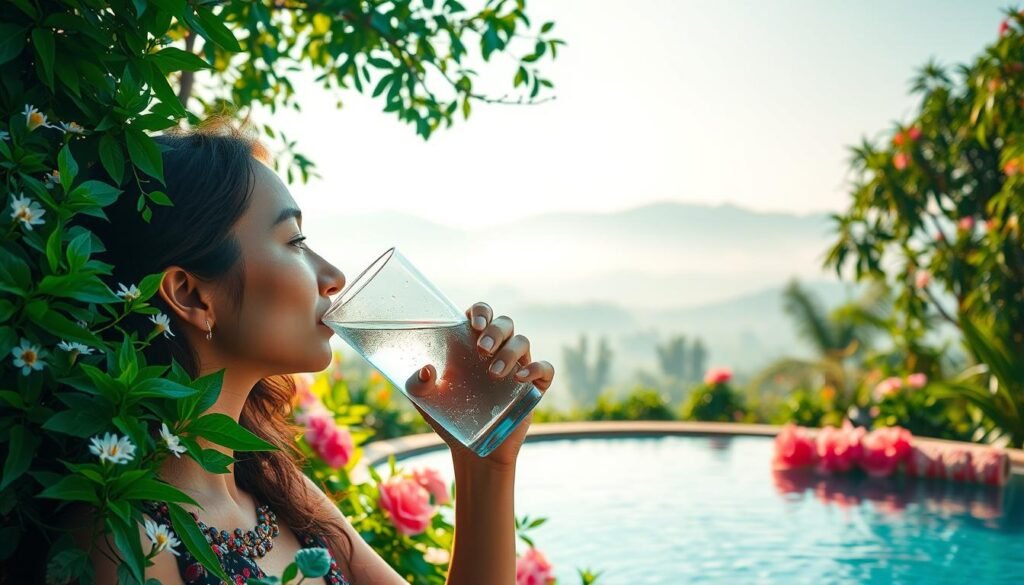Water is more than just a basic need; it’s the fuel for every cell in your body. It helps your organs work right and makes your mind sharper. Think of it as the silent partner that boosts your energy, mood, and skin’s glow.
Your brain needs water to work well. Even a little dehydration can make you feel slow and grumpy. Your muscles and joints also need water to move smoothly. Drinking water helps you stay focused and active, whether you’re working out or working hard.
But hydration does even more. It helps your body digest food, keeps your temperature stable, and removes toxins. Not drinking enough can lead to headaches, tiredness, or dry skin. Let’s see how making water a priority can change your life for the better.
Key Takeaways
- Water supports critical bodily functions like digestion and temperature control
- Mental focus and mood improve with consistent hydration
- Dehydration can trigger fatigue, headaches, and joint discomfort
- Skin health visibly reflects your hydration habits
- Balanced fluid intake enhances physical performance
Understanding the Basics of Hydration
Water is more than just a drink to quench our thirst. It’s essential for our cells to function properly. This part explains how water works at a molecular level. It shows why no other substance can replace water’s importance for life.
What is Hydration?
Hydration means your body can keep fluids balanced. This balance is key for cells to work right. They need water to:
- Move nutrients and oxygen
- Get rid of waste
- Send nerve signals
- Stay flexible and work well
Your body loses about 2.5 liters of water every day. This loss happens through breathing and sweating. So, drinking water regularly is vital for keeping cells healthy.
Why Water is Essential for Life
Water has three special qualities that make it unique:
| Property | Biological Benefit | Example |
|---|---|---|
| Universal Solvent | Dissolves nutrients for absorption | Carries vitamins through bloodstream |
| High Heat Capacity | Regulates body temperature | Sweat cools skin during exercise |
| Polarity | Enables chemical reactions | Breaks down food during digestion |
No sports drink or juice can do what water does. The role of water in promoting well-being is unmatched. It’s because water:
- Is absorbed without digestion
- Has no additives that harm organs
- Keeps the body’s pH balanced naturally
The Role of Water in Body Functioning
Water is a silent partner in your body, powering key systems that keep you alive and healthy. It helps maintain balance and fuels cells. The benefits of adequate hydration are vast, going beyond just quenching thirst. Let’s dive into how water drives three vital bodily functions.
Regulating Body Temperature
Your body loses about 1.5 liters of water daily through sweat. This cooling system prevents overheating during exercise or in hot weather. When it gets hot:
- Blood vessels expand to release heat
- Sweat glands activate to produce moisture
- Evaporation cools skin surface efficiently
Research shows the average adult’s fluid turnover rate increases by 40% during physical activity. Organs like skin and muscles account for 60% of this water redistribution.
Supporting Digestion and Nutrient Absorption
Water starts digestion when food enters your mouth. Proper hydration increases saliva production by 50%, helping break down carbs. In the stomach:
- Hydrochloric acid uses water to dissolve nutrients
- Liquid helps form digestible food particles
- Water-soluble vitamins get transported to bloodstream
The small intestine absorbs 95% of nutrients through water-based solutions. Dehydration reduces this efficiency by up to 30%, according to digestive health studies.
Supporting Joint Health
Synovial fluid – your joints’ natural lubricant – contains 85% water. This fluid:
| Function | Water Contribution |
|---|---|
| Reduces friction | Maintains viscosity |
| Shock absorption | Provides cushioning |
| Nutrient delivery | Transports minerals |
Cartilage repair slows by 45% when hydration levels drop below optimal. Daily water intake helps maintain joint flexibility and prevents stiffness during movement.
The Mind-Body Connection: Hydration and Mental Well-being
Water doesn’t just fuel your muscles – it powers your brain. Research shows that even a little dehydration can mess with your mind. It affects your focus and mood, impacting your daily life.
Impact of Dehydration on Cognitive Functions
Just a 2% drop in body water can make you feel foggy. Studies show that dehydrated adults:
- React 15% slower to problems
- Have working memory like they missed a night’s sleep
- Make more mistakes in complex decisions
It’s not just athletes who feel the effects. Office workers also see a 30% drop in focus during tests. This happens because water helps your brain cells talk to each other and get the nutrients they need.
“Dehydration makes your brain work harder. It’s like trying to drive a car with low oil – everything slows down.”
Hydration and Mood Regulation
Your water bottle might be the ultimate mood booster. Drinking enough water helps make serotonin, the “happy” hormone. Studies show:
- Drinking 5+ glasses a day can cut anxiety by 45%
- Teenagers who drink water regularly have lower depression scores
- Starting your day with water helps you handle stress better
On the other hand, not drinking enough water can make you feel stressed and tired. A UCLA study found that dehydrated people got frustrated 20% more during tests than those who drank water.
Practical tip: Keep water in sight when you’re working hard. Drinking water regularly can help you stay focused by 12% during the afternoon.
Recognizing Symptoms of Dehydration
Early signs of dehydration are easy to overlook but very important to catch. If ignored, dehydration can quickly become serious. Knowing these signs helps you stay hydrated and avoid harm.

Early Signs of Dehydration
Your body gives clear signals when it needs more water. Look out for these common signs:
- Dry mouth or sticky saliva
- Reduced urination with dark yellow urine
- Headaches or mild dizziness
- Fatigue or irritability
- Dry, cool skin
Thirst is not always the first sign. By the time you feel thirsty, dehydration may have already begun. People who work in offices or athletes often miss early signs like trouble focusing or muscle cramps.
Serious Consequences of Severe Dehydration
When you lose more than 5% of your body weight in fluids, symptoms get worse fast. Severe dehydration needs quick medical help and can lead to:
- Rapid heartbeat or low blood pressure
- Sunken eyes or shriveled skin
- Confusion or loss of consciousness
- Organ failure (kidneys, liver, or heart)
| Condition | Key Symptoms | Differentiating Factor |
|---|---|---|
| Dehydration | Dry mucous membranes, reduced sweat | Responds to fluid intake |
| Heat Exhaustion | Nausea, heavy sweating | Requires cooling measures |
| Hyponatremia | Swelling, seizures | Excess water, low sodium |
Doctors say severe dehydration can look like other problems. For example, dizziness might seem like low blood sugar, and fast breathing could look like anxiety. Always check how much water you’re drinking when you feel symptoms.
Drinking enough water is more than just feeling good. It’s a way to avoid serious problems. Drink water regularly and eat foods with electrolytes when it’s hot or you’re active to keep your body balanced.
Hydration and Physical Performance
Drinking enough water is more than just staying hydrated. It’s a key factor for athletes to reach their best. Water helps muscles work better, keeps blood flowing, and speeds up recovery. Even a little dehydration can hurt performance, making it crucial for athletes and those who work out.
Water’s Role in Athletic Performance
Studies show that losing 3% of body weight in fluids can cut strength by up to 10%. This affects power in weightlifting, sprinting, and intense workouts. Water also:
- Lubricates joints to prevent injury
- Delivers oxygen to working muscles
- Regulates core temperature during exertion
“Dehydration is the silent saboteur of athletic progress. Prioritizing fluid intake is non-negotiable for competitive results.”
Effects of Dehydration on Exercise Endurance
Dehydration makes the heart work harder because blood gets thicker. This can lead to early fatigue, poor coordination, and slower recovery. Adjusting how much you drink based on your workout intensity can help:
| Drink Type | Best For | Key Ingredients | Hydration Speed |
|---|---|---|---|
| Isotonic | Endurance training (60+ mins) | 6-8% carbs, electrolytes | Fast absorption |
| Hypotonic | Short, intense sessions | Low carbs, high electrolytes | Very fast absorption |
For personalized advice, check out sports and hydration strategies from top medical experts. Finding the right balance of fluids before, during, and after exercise can boost focus and energy.
Daily Hydration Goals: Finding Your Needs
Everyone needs different amounts of water, and one rule doesn’t fit all. The “8 glasses a day” idea is outdated. Instead, we should use science to figure out how much water we need.
![]()
Factors Influencing Hydration Requirements
There are four main things that affect how much water you need:
- Body composition: People with more muscle need more water
- Activity intensity: You lose water when you exercise, so you need to replace it
- Local climate: Where you live affects how much water you lose
- Health status: Being pregnant or having kidney issues changes your needs
| Factor | Impact on Needs | Adjustment Example |
|---|---|---|
| Weight (150 lbs vs 200 lbs) | +20% more water | 75 oz → 90 oz daily |
| Moderate Exercise (1 hour/day) | +16-24 oz | Add during/after activity |
| High-Heat Environment | +25% baseline | Monitor urine color |
Guidelines for Daily Water Intake
Here’s a simple way to figure out how much water you need:
- Base requirement: Body weight (lbs) ÷ 2 = minimum ounces
- Activity multiplier: Add 12 oz per 30 minutes of exercise
- Climate adjustment: Include 16 oz extra for hot/humid days
For a 180-pound office worker exercising 45 minutes daily:
90 oz (base) + 18 oz (exercise) + 0 (climate) = 108 oz total
Don’t wait until you’re thirsty to drink water. Use a reusable bottle with markers to keep track of your intake.
Sources of Hydration Beyond Water
While water is the best for staying hydrated, almost 20% of our daily fluid intake comes from other sources. This includes food and drinks. We’ll look at new ways to stay hydrated and clear up myths about other sources.
Hydrating Foods: Fruits and Vegetables
Many foods are like natural water bottles. Here are some top picks:
- Cucumbers (96% water) – like drinking half a glass of water
- Watermelon and strawberries (91-92% water)
- Spinach (93% water) – great for salads or smoothies
- Bananas (74% water) – perfect for potassium and staying hydrated
These foods give you hydration and important nutrients. A 2023 study on nutrition showed that eating water-rich foods can cut down on the need for plain water by 30%.
Other Beverages: What Counts Toward Hydration?
Many drinks help keep our bodies balanced:
- Herbal teas: They hydrate as well as water since they don’t have caffeine
- Milk: It has electrolytes and is 90% water
- Vegetable juices: Low-sodium ones give fluids and vitamins
Good news for coffee lovers: moderate drinking (3-4 cups a day) doesn’t lead to dehydration. Electrolyte drinks are good for athletes, but regular water and balanced meals are better for long-term hydration and health.
Hydration Best Practices for Different Lifestyles
Your daily routine shapes your hydration needs. Whether you’re stuck at a desk or hiking trails, there are tailored strategies for you. Let’s look at science-backed approaches for two common scenarios.

Hydration Tips for Office Workers
Desk jobs make staying hydrated a challenge. The Occupational Safety and Health Administration (OSHA) suggests having water nearby. Here are some practical tips:
- Use smart water bottles with reminder alerts and intake tracking
- Take a water break every time you finish a task
- Keep a 20-ounce tumbler visible on your desk
| Office Hydration Strategy | Benefit | OSHA Compliance Tip |
|---|---|---|
| Timed bottle refills | Prevents dehydration headaches | Ensure clear pathways to water stations |
| Hydration apps | Tracks daily intake goals | Use phone stands for visible reminders |
| Desk plants | Increases humidity awareness | Choose non-spill containers |
Staying Hydrated During Outdoor Activities
National Park Service (NPS) guidelines suggest carrying 1 liter of water per 2 hours of moderate hiking. Adventure enthusiasts should remember:
- Pre-hydrate with 16-20 oz of water 2 hours before activity
- Use electrolyte tablets during extended exertion
- Monitor urine color using a portable UV light keychain
“Hyponatremia prevention requires balancing water intake with electrolyte replacement during endurance activities.”
Compare these approaches for better health outcomes:
| Factor | Office Workers | Outdoor Enthusiasts |
|---|---|---|
| Daily Water Needs | 2.7-3.7 liters | 4-6 liters |
| Key Risk | Chronic mild dehydration | Acute electrolyte imbalance |
| Best Tool | Smart reminder bottle | Hydration bladder with filter |
The Impact of Climate on Hydration Needs
Climate isn’t just about weather—it affects how much water your body needs. Extreme temperatures, humidity, and altitude all play a role. This means hydration strategies must be tailored to your environment for optimal health.
Hydration in Hot and Humid Weather
In hot weather, your body sweats up to 1.5 liters per hour to cool down. High humidity makes it harder for sweat to evaporate, increasing the effort needed. The CDC’s heat index charts show:
- At 90°F with 60% humidity, dehydration risk doubles
- Fluid loss accelerates by 25% during outdoor activities
- Electrolyte imbalance becomes likely after 2 hours of exposure
To stay ahead of thirst in these conditions:
- Drink 16-20 oz of water 2 hours before outdoor activities
- Replace 8 oz every 15 minutes during exertion
- Monitor urine color—pale yellow indicates proper hydration
Cold Weather and Its Effects on Hydration
Winter poses its own hydration challenges. Cold air holds less moisture, leading to rapid respiratory water loss. At high altitudes, altitude diuresis causes frequent urination, adding to fluid loss.
“Mountain athletes lose 50% more water through respiration than at sea level, requiring 25% increased fluid intake.”
Three cold-weather hydration myths to avoid:
- ❌ “You don’t sweat in winter” (You lose 30-40% through layered clothing)
- ❌ “Hot drinks dehydrate you” (Herbal teas count toward intake)
- ❌ “Thirst is a reliable indicator” (Cold suppresses thirst signals)
Myths and Misconceptions About Hydration
Hydration advice often gets mixed up with false information and marketing tricks. Let’s clear up the truth to help you choose wisely about water and electrolytes.

Debunking Common Hydration Myths
Myth 1: “Clear urine means perfect hydration.” While pale yellow urine is good, clear urine might mean you’re drinking too much. Your body gets rid of extra water, which can lose important electrolytes.
Myth 2: “Everyone needs 8 glasses daily.” The amount of water you need depends on how active you are, where you live, and your health. For example, someone working in a cool office might need less than someone working outside in Phoenix.
Myth 3: “Sports drinks beat water for workouts.” Unless you’re doing very intense exercise for over 90 minutes, water is usually enough. Most people don’t sweat enough to need the extra sugar and electrolytes in sports drinks.
Understanding Electrolytes vs. Water
Electrolytes like sodium and potassium help keep fluids balanced, but they’re not a quick fix for staying hydrated. You might need extra electrolytes if:
- You get muscle cramps during long workouts
- You’re recovering from a stomach bug with vomiting or diarrhea
- You work in extreme heat for hours
| Situation | Water | Electrolytes |
|---|---|---|
| 30-minute walk | ✔️ Ideal | ❌ Unnecessary |
| Marathon training | ✔️ Essential | ✔️ Recommended |
The benefits of adequate hydration are best when you tailor it to yourself. Pay attention to your thirst, check your urine color, and adjust as needed based on your activity level.
Hydration in Special Populations
Hydration needs change with age. Kids and seniors have different needs due to their bodies’ changes. Water is key for everyone, but how much and how often depends on age.
Importance for Children and Adolescents
Young ones don’t always know when they’re thirsty. This can lead to dehydration, especially during play or school. Schools can help by offering water breaks and teaching about the importance of staying hydrated.
- Providing water breaks during recess and gym classes
- Allowing water bottles in classrooms
- Educating students about hydration’s role in focus and energy
Water is crucial for kids’ growth, brain health, and immune system. It also helps teens manage their metabolism during growth.
Hydration Needs in Older Adults
As we age, our bodies don’t signal thirst as well. This, along with some medications, increases the risk of dehydration. To stay hydrated, older adults can try drinking water at set times and watching urine color.
- Drinking water at scheduled times, even without thirst
- Monitoring urine color for hydration clues
- Incorporating soups or herbal teas for added fluid intake
It’s best for caregivers to encourage small, frequent sips to avoid discomfort.
| Population | Key Challenge | Daily Water Goal* |
|---|---|---|
| Children (4-8 years) | Underdeveloped thirst signals | 5 cups (1.2L) |
| Teens (14-18 years) | High activity levels | 7-11 cups (1.7-2.6L) |
| Adults 65+ | Reduced kidney function | 6-8 cups (1.5-1.9L) |
*Based on National Academies of Sciences guidelines. Individual needs may vary.
Incorporating Hydration into Your Daily Routine
Creating a habit of drinking water is all about making small changes. Adjusting your surroundings and mindset can turn drinking water into a simple habit. We’ll look at ways to make staying hydrated for optimum wellness a natural part of your day.
Simple Strategies to Increase Water Intake
Begin with habit stacking. Link drinking water to things you already do, like brushing your teeth or checking emails. These small habits are easy to follow and don’t need much effort.
Here are some proven methods:
- Use visual reminders: Keep water bottles in places you often visit, like your desk or kitchen counter
- Flavor infusion: Add cucumber slices or mint leaves to make water more enjoyable
- Set interval goals: Try to drink a certain amount at 10 AM, 2 PM, and 6 PM
Tech Tools for Tracking Hydration
Apps and devices make it easy to stay hydrated. They include:
| Tool | Key Features | Integration |
|---|---|---|
| Waterllama | Customizable goals, hydration streaks | Apple Health |
| Hydro Coach | Activity-based adjustments | Google Fit |
| HidrateSpark PRO | Glowing reminders, auto-tracking | Both platforms |
Smart water bottles like HidrateSpark connect with fitness trackers. They track how much you drink and remind you with gentle lights. This mix of physical and digital cues helps you stay on track.
The Long-Term Benefits of Proper Hydration
Drinking enough water does more than just quench your thirst. It lays the groundwork for a lifetime of health. Studies show that regular water intake boosts physical strength, sharpens the mind, and fights off diseases. Let’s dive into how this simple habit can lead to lasting health benefits.
Enhanced Overall Health and Wellness
Drinking water is like having an internal maintenance crew. A 15-year NIH study found that adults who drank enough water had 28% fewer chronic health complaints than those who didn’t. The benefits include:
- Plumper skin cells that look younger
- Efficient removal of toxins by the kidneys and liver
- More energy thanks to better blood flow
People who drink water regularly also have better digestion and fewer headaches, says Johns Hopkins. Feeling good encourages more healthy choices. This creates a positive feedback loop.
Preventative Care: Hydration and Disease Prevention
Dehydration can quietly harm organs over time. Key studies show:
| Condition | Risk Reduction | Study Source |
|---|---|---|
| Kidney stones | 40% lower | Brigham and Women’s Hospital |
| UTI recurrence | 32% decrease | American Urological Association |
| Early dementia signs | 26% slower progression | Neurology Journal |
New research suggests that drinking water might also help control blood pressure and reduce arthritis inflammation. While it’s not a magic solution, it works well with other healthy habits to boost the body’s defenses.
“Chronic mild dehydration is like driving a car with low oil – you might not see immediate damage, but the long-term wear adds up.”
Conclusion: Making Hydration a Priority for Well-being
Drinking enough water is key for both body and mind. Harvard Medical School found that even a little dehydration can make you less focused. Drinking water regularly helps your organs work better and keeps your joints moving smoothly.
Begin with small steps to make drinking water a habit. Use a bottle like Hydro Flask or Yeti to see how much you drink. Try drinking water before meals or during breaks at work. Apps like MyFitnessPal or Waterllama can remind you to drink based on your activity and the weather.
Eat foods that are full of water, like cucumbers, watermelon, and oranges. Athletes can use products like Liquid I.V. or Nuun Sport for extra electrolytes without too much sugar. Older adults might want to set reminders on smart devices like Apple Watch to drink more water.
Drinking more water can help prevent health problems like kidney stones and urinary tract infections. Seeing water as a way to prevent health issues can make you more productive every day. You can tell if you’re doing well by looking at your skin, feeling more energetic, and recovering faster from workouts.
Make one change this week to improve your hydration. It could be drinking sparkling water instead of soda or setting reminders to drink water. Share your plan with friends or join a challenge on Fitbit to stay on track and motivate others.

